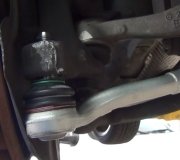One thing you can try yourself is to grab each front tire and try to turn it left and right back and forth a couple of times per second. This is hard to describe, but it's better if you have the key in the ignition so you can unlock the steering column. Just try to move the tire left and right a couple of inches. What you should feel is, ... Uhm, ... Nothing unusual, if that makes sense. You'll be moving the entire steering linkage and steering column up to the steering wheel. If the lock isn't released you might feel the steering wheel banging into it. What you want to identify, if it is present, is a knocking feeling near the wheel you're tugging on. You will be moving a metal ball that sits inside a metal socket. There must be no slop or play between those parts. If there is, you will feel it as a light clunking feeling.
You're actually tugging on two tie rod ends at the same time. It is way too common for the outer tie rod end to develop this wear. When it does, it isn't long before it comes apart and you can't control that wheel. The inner tie rod end is of a different design. It is less common for them to develop looseness, and it is not common at all for them to separate, even on Fords.
If you feel any clunking, you'll have to get a friend to do that while you look underneath to identify which one is loose. It's real hard to look and tug on the tire at the same time.
To get more involved, you can do the same test with the front of the car raised off the ground. If you can feel the looseness while tugging back and forth on the tire with just one hand, it's best to drive it slowly right to the repair shop as it's about to come apart. Use both hands so it's easier to feel the sensation of the looseness. Do that on both front tires.
If you have the car jacked up, and IF you are lucky enough to have found no looseness, do that again but this time tug really hard and quickly on the tire. In this way you're using it as a lever to push and pull on the lower ball joint. That is another ball and socket and they also give a lot of trouble on Fords. If the ball joint is loose you will feel the bottom of the tire move in and out and it is pretty easy to see it too. It takes a lot more force to identify a loose ball joint than it does for a tie rod end, and a ball joint can't be checked with the tires on the ground.
When a tie rod end has looseness it will let that tire turn left and right a little while you're holding the steering wheel straight. When a ball joint has looseness it lets the bottom of the tire squirt out away from the car. That will also change the relationship with the tie rod end and cause the tire to turn out. Either of those can let the tire shake back and forth and could be what you're feeling. That can be intermittent too depending on vehicle speed, tire temperature, road surface and smoothness, etc. When that shaking occurs, it causes a hammering action on the loose parts, and that hammering increases the wear very rapidly. That's why those parts can fail so soon after they checked good.
Now, there are some other, less serious things that can cause an intermittent shaking. Worn struts and warped brake rotors come to mind first but given the history of this car model and your description, I think you're going to find loose tie rod ends. If you don't feel comfortable inspecting them yourself, take the car to a tire and alignment shop. They know all the things to look for and can recommend the needed repairs. The good news is both the outer tie rod ends and the lower ball joints take very little time to replace. I did so many tie rod ends years ago that I could them on Escorts and Tempos in less than five minutes each without even removing the wheels.
Friday, April 8th, 2011 AT 6:07 AM


